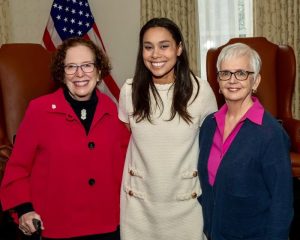Major Book Event: Meetup With Taft Descendent

Ann McClellan, Patricia Taft and Diana Parsell at University Club on March 23
In events surrounding the launch of my bool on Eliza Scidmore, it was thrilling — and great fun — to share the stage with presidential great-granddaughter Patricia Taft.
We were the featured speakers at a sold-out “Still Blooming Luncheon” on March 23 at the University Club in Washington. The event, sponsored by the National Cherry Blossom Festival, featured a discussion on First Lady Helen Taft and travel writer Eliza Scidmore, whose collaboration a century ago led to the gift of flowering cherry trees from Tokyo to Washington, D.C.
Patricia Taft, of Santa Monica, California, Los Angleles, was born into the Taft political dynasty in 1984 as the daughter of Lloyd Bowers Taft Sr., of Taft Broadcasting, and his wife, Carolyn Moore Taft. Her grandfather was the esteemed senator Robert A. Taft Sr. Owner of a an interior design firm, Patricia is a member of the National First Ladies Day Commission.
Patricia offered unique family perspective on her great-grandmother Helen Herron Taft, while I discussed research findings from my newly published biography of Scidmore. Ann McClellan, an expert on Washington’s cherry trees and the author of two related books, organized and moderated the event.
The discussion included comments on the like-minded personalities of Mrs. Taft and Eliza Scidmore. Both were strong-willed women of executive abilities. They also shared strong humanitarian instincts, as reflected in their great curiosity about the world and their tolerant attitude toward people of other classes and cultures.
Their partnership in the cherry trees began soon after the Tafts came to the White House in 1909. Mrs. Taft and the president were very interested in the development of Potomac Park, which had been created on a formerly marshy mud bank along the river. Eliza had reported on the park’s development for years as a reporter in Washington.
Mrs. Taft, a trained musician, ordered a bandstand built in Potomac Park as a gathering place where people from all walks of life could enjoy public concerts on pleasant afternoons. It was an idea that came to her after she had a similar experience while living in Manila, where crowds gathered at a riverside spot known as the “Lunetta.”
Upon hearing of Mrs. Taft’s idea, Scidmore realized it was compatible with her own longtime efforts to have Japanese cherry trees planted along the Potomac. After Scidmore sent a note seeking the First Lady’s support, Mrs. Taft took up the idea and ran with it. Eliza’s contacts with well-placed Japanese kicked the project up several notches when it led to the offer of a gift of a couple thousand cherry trees from Tokyo to Washington.
The project hit a big snag when the donated trees arrived and were found to be badly infested. The entire batch was burned, for fears the infested trees could pose a threat to U.S. agriculture. Fortunately, the Japanese graciously sent a replacement batch, grown under pristine conditions.
The first two saplings in that second shipment of 3,000 trees were finally planted alongside the Tidal Basin on May 27, 1912. Eliza was one of only three special guests of Mrs. Taft’s on hand to witness the historic event.
